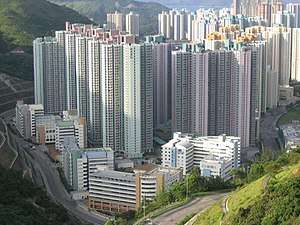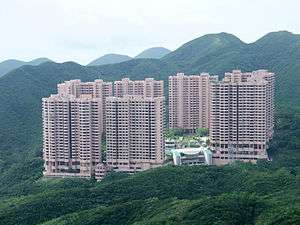Housing in Hong Kong
Housing in Hong Kong varies by location and income. More than 7 million people live on about 1,108 km² (427 mi²) of land in the region, making it one of the densest places in the world.



Housing statistics
According to the 2016 by-census the breakdown by type of housing was as follows:[1]
- Public rental housing: 29.1%
- Housing Authority Subsidized sale flats: 15.8%
- Private permanent housing: 53.2%
- Temporary housing: 0.7%
- Non-domestic housing: 1.2%
In 2016 the total Hong Kong population was 7.3 million, and 53% of domestic households were living in private permanent housing and 30.4% were in public rental housing. Another 15.3% of domestic households were living in subsidized home ownership housing.[2]
According to the 2014/2015 Household Expenditure Survey, housing accounted for an average of 36% of average monthly household expenditure, with utilities accounting for an additional 3%.[3]
Public housing
Public housing is a major component of the housing in Hong Kong. About half of Hong Kong residents now live in public housing estates (Chinese: 公共屋邨) and other tower blocks with some form of subsidy. The history of public housing in Hong Kong can be traced back to the 1950s, where masses of people surged into Hong Kong due to political turmoil on the mainland. This led to a drastic increase in the number of squatters. Fires were common in these unhygienic and cramped makeshift homes.[4][5] In 1953, a fire in Shek Kip Mei destroyed the shanty homes of approximately 53,000 people. In response the Hong Kong Government commenced a programme of mass public housing, providing affordable homes for low income citizens.[6]
Several subsidized home ownership programs have been implemented, including: Home Ownership Scheme, Flat-for-Sale Scheme, Tenants Purchase Scheme, Sandwich Class Housing Scheme and Private Sector Participation Scheme.
High Costs
There are many contributing factors to Hong Kong's extremely high cost of housing. Though Hong Kong's economy is based on positive non-interventionism, the government intervenes heavily in housing, disrupting free-market economics. For example, the Small House Policy guarantees male indigenous villagers a grant to build his own house, an unsustainable policy due to shortage of land. Though Carrie Lam has called for an end to the policy,[7] the Heung Yee Kuk, which represents villagers, has spent resources to challenge changes to the policy.[8]
Segmentation
In the high-end market, the Peak is ranked the 3rd most expensive city in the world in 2007 with a square foot per unit pricing of US $2,008 behind London and Monaco.[9]
Hong Kong's home prices also top the list of least affordable markets among major world cities according to American research institution Demographia's latest report in January 2015. The Demographia International Housing Affordability Survey 2015 includes 378 property markets around the globe, generating Median Multiples according to the proportion of average property price to median household income. Results are categorized into 4 levels: Affordable (Below 3 times), Moderately Unaffordable (3.1 to 4 times), Seriously Unaffordable (4.1 to 5 times) and Severely Unaffordable (5.1 times and over). Hong Kong falls into the grading of ‘Severely Unaffordable’, with the highest recorded index of 17.0 since the report commenced 11 years ago. Second on the list was Vancouver with an index of 10.6, still significantly lower than HK.[10]
Due to recurring issues with housing unaffordability, the government commissioned the Task Force on Land Supply[11] in 2017, which in 2019, presented a report to the Legislative Council with suggestions on increasing the supply of housing. The government's response was that Chief Executive ordered that all recommendations by the Task Force be accepted.
Housing estates
.jpg)
Traditional and historical housing
See also
- List of tallest buildings in Hong Kong
- Architecture of Hong Kong
- Bedspace apartment
- Subdivided flat
- Small House Policy
- Demographics of Hong Kong
- Economy of Hong Kong
- Asian property market
- Land and the Ruling Class in Hong Kong, a book related to the housing of the city

References
- Census and Statistics Department - Population by type of housing 2006, 2011, and 2016 (E101)
- Census and Statistics Department - Domestic Households by Type of Housing, 2006, 2011, and 2016 (E103)
- Census and Statistics Department - Household Expenditure Survey
- Rosario, Louise do (30 March 1995). "HONG KONG --- Long Way From a Home: Housing programme can't keep up with demand". Far Eastern Economic Review. Vol. 31. p. 1 – via The Hang Seng University of Hong Kong Library.
- "Public Housing Development | Hong Kong Housing Authority and Housing Department". www.housingauthority.gov.hk. Retrieved 2019-03-04.
- Choi, Barry (30 June 1975). "Housing means more than a roof" (PDF). South China Morning Post. Retrieved 7 February 2007.
- "Male villager privileges retained in landmark ruling on small-house policy". South China Morning Post. 2019-04-08. Retrieved 2020-06-27.
- "Small-house policy: why not all Hongkongers are born equal". South China Morning Post. 2019-05-01. Retrieved 2020-06-27.
- ABC News. "ABC News Go." "Hong Kong's Real Estate is World's Peak." Retrieved on 2007-04-06.
- http://www.okay.com/en/property-news/Hong-Kongs-residential-property-prices-graded-as-Worlds-Most-Severely-Unaffordable-/276?nid=38
- "Task Force on Land Supply". www.landforhongkong.hk. Retrieved 2020-02-13.
External links
| Wikimedia Commons has media related to Housing in Hong Kong. |